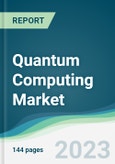The application of Quantum theory in computer science is known as quantum computing. It is related to the idea of using subatomic particles, such as electrons or photons. It all falls under quantum computing. Armed with these quantum bits, or qubits, the particles could vary in two states at once. Conventional computers use a binary operation of electric signals to represent information in terms of bits (1 and 0). This limits the amount of information that can be processed by them as compared to quantum computing.
Moreover, quantum computing can separate the potential solutions from the challenging problems, and reduce everything to a manageable power. Additionally, they have a major role in diverse industries from security to banking, military intelligence, drug discovery, aircraft designs, utilities (nuclear fusion), polymer design, and machine learning processes; merging artificial intelligence responding triggers big data search & digital manufacturing. They could be used to enhance encrypted information transfer or for better missile/airplane recognition by radars.
Additionally, the quantum computing market will experience expansion during the forecasted period due to various variables including the government investing in quantum technologies by providing subsidies as well as collaborating with private organizations and corporations. Additionally, the advanced quantum technologies used in large-scale optimization are also rising for multiple sectors for faster quantum algorithm performance results.
Quantum computing market drivers
Government investments and partnerships with private companies aimed at digitization support.Governments around the world recognize the vital significance of quantum innovation, which has the potential to revolutionize different businesses. Major ventures are being made in quantum research and advancement, supporting the improvement of new equipment, programs, and algorithms. Government initiatives have been set up to cultivate advancement and maintain innovative administration. Collaborations between governments and private companies can quicken the improvement and commercialization of quantum computing applications. Governments are given subsidizing, infrastructure, and expertise, whereas private companies contribute their innovative capabilities and market information.
Moreover, governments are spending majorly on quantum computing innovation, which reflects the growing demand for the technology. For instance, in November 2022, The German Aerospace Center (DLR) called for proposals for the improvement of quantum computing with solid-state spins. The initiative focuses on constructing models of quantum computers over four years. The primary sub-project aimed at a transportable demonstrator for preparation was aimed to be completed by 2023. The second sub-project was to create and construct a model of a quantum processor based on solid-state spins. The framework is extended to 50 qubits or more over several phases. The venture, which ran for three and a half years, focused on progressing quantum innovation and digitalization.
Additionally, the Union Cabinet announced the approval of the National Quantum Mission (NQM) on 19th April 2023, costing Rs. 6,003.65 crore from 2023-24 to 2030-31. The mission objective is to propel scientific and mechanical R&D, make a dynamic QT environment, and quicken QT-led economic development. The mission focuses on creating intermediate-scale quantum computers with 50-1,000 physical qubits in 8 years utilizing stages like superconducting and photonic innovation.
This could also lead to better quality computing solutions getting developed due to more strategic collaborations happening by major players and organizations. As an example of this, a high-level team from Finland visited the Centre for Development of Advanced Computing (C-DAC), Pune in December 2022 to explore potential areas and opportunities for bilateral cooperation in the following thematic segments on quantum technologies, HPC-quantum integration, and applications.
Reasons for buying this report:
- Insightful Analysis: Gain detailed market insights covering major as well as emerging geographical regions, focusing on customer segments, government policies and socio-economic factors, consumer preferences, industry verticals, other sub-segments.
- Competitive Landscape: Understand the strategic maneuvers employed by key players globally to understand possible market penetration with the correct strategy.
- Market Drivers & Future Trends: Explore the dynamic factors and pivotal market trends and how they will shape up future market developments.
- Actionable Recommendations: Utilize the insights to exercise strategic decision to uncover new business streams and revenues in a dynamic environment.
- Caters to a Wide Audience: Beneficial and cost-effective for startups, research institutions, consultants, SMEs, and large enterprises.
What do businesses use our reports for?
Industry and Market Insights, Opportunity Assessment, Product Demand Forecasting, Market Entry Strategy, Geographical Expansion, Capital Investment Decisions, Regulatory Framework & Implications, New Product Development, Competitive IntelligenceReport Coverage:
- Historical data & forecasts from 2022 to 2030
- Growth Opportunities, Challenges, Supply Chain Outlook, Regulatory Framework, Customer Behaviour, and Trend Analysis
- Competitive Positioning, Strategies, and Market Share Analysis
- Revenue Growth and Forecast Assessment of segments and regions including countries
- Company Profiling (Strategies, Products, Financial Information, and Key Developments among others)
The Quantum computing market is segmented and analyzed as follows:
By Component
- Hardware
- Software and Service
By Deployment
- On-Premises
- Cloud-Based
By Industry Vertical
- BFSI
- Automotive
- Manufacturing
- Healthcare
- IT & Telecom
- Energy & Power
- Others
By Applications
- Artificial Intelligence & Machine Learning
- Computational Chemistry
- Drug Design & Development
- Cybersecurity & Cryptography
- Financial Modelling
- Logistics Optimisation
- Others
By Geography
- North America
- South America
- Europe
- Middle East and Africa
- Asia-Pacific
Table of Contents
Companies Mentioned
- IBM
- Microsoft
- Quantum Computing Inc.
- Intel Corporation
- D-Wave Quantum Inc.
- Quix Quantum BV
- Alpine Quantum Technologies GmbH
- ORCA Computing
- Rigetti & Co, LLC.
- Google LLC
- Nanofiber Quantum Technologies
- IQM Finland Oy
Table Information
| Report Attribute | Details |
|---|---|
| No. of Pages | 144 |
| Published | December 2024 |
| Forecast Period | 2025 - 2030 |
| Estimated Market Value ( USD | $ 1.79 Billion |
| Forecasted Market Value ( USD | $ 7.08 Billion |
| Compound Annual Growth Rate | 31.6% |
| Regions Covered | Global |
| No. of Companies Mentioned | 12 |









